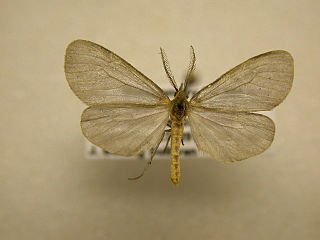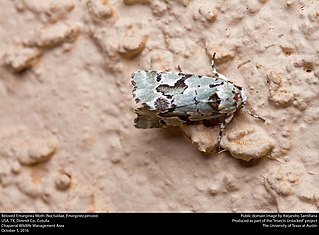Inopsis is a genus of moths in the family Erebidae. The genus was described by Felder in 1874.

Pagara is a monotypic moth genus in the family Erebidae. Its only species, Pagara simplex, the mouse-colored lichen moth, is found in North America, where it has been recorded from Alabama, Arkansas, Florida, Georgia, Illinois, Indiana, Iowa, Kansas, Kentucky, Maryland, Mississippi, New Hampshire, North Carolina, Ohio, Oklahoma, South Carolina and Tennessee. Both the genus and species were described by Francis Walker in 1856.

Prosoparia is a genus of moths of the family Erebidae. The genus was erected by Augustus Radcliffe Grote in 1883.
Trocodima fuscipes is a moth of the family Erebidae. It was described by Augustus Radcliffe Grote in 1883. It is found in the US state of Arizona.

Chrysendeton medicinalis, the bold medicine moth, is a moth in the family Crambidae. It was described by Augustus Radcliffe Grote in 1881. It is found on North America, where it has been recorded from Alabama, Florida, Georgia, Illinois, Indiana, Kentucky, Maryland, Mississippi, North Carolina, Ohio, Pennsylvania, South Carolina, Tennessee, Texas and West Virginia.
Elophila ekthlipsis, the nymphula moth, is a moth in the family Crambidae. It was described by Augustus Radcliffe Grote in 1876. It is found in North America, where it has been recorded from the Great Lakes area, including Indiana, Maine, Michigan, Minnesota, New Brunswick, New Hampshire, Ohio, Ontario, Quebec and Wisconsin. The habitat consists of ponds and marshes.
Agriphila anceps is a moth in the family Crambidae. It was described by Augustus Radcliffe Grote in 1880. It is found in North America, where it has been recorded from California.
Crambus occidentalis is a moth in the family Crambidae. It was described by Augustus Radcliffe Grote in 1880. It is found in North America, where it has been recorded from Alberta and California.
Evergestis obliqualis is a moth in the family Crambidae. It was described by Augustus Radcliffe Grote in 1883. It is found in North America, where it has been recorded from Arizona, California, Colorado, New Mexico, Texas and Utah.
Evergestis simulatilis is a moth in the family Crambidae. It was described by Augustus Radcliffe Grote in 1880. It is found in North America, where it has been recorded from Alberta, Arizona, British Columbia, California, Colorado, Montana, Nevada and New Mexico.
Loxostege albiceralis is a moth in the family Crambidae. It was described by Augustus Radcliffe Grote in 1878. It is found in North America where it has been recorded from southern California and Nevada to Texas. The habitat consists of arid areas and deserts.
Loxostege indentalis is a moth in the family Crambidae. It was described by Augustus Radcliffe Grote in 1883. It is found in North America, where it has been recorded from California, Nevada, Utah, Oregon, Washington and Montana.
Xanthostege plana is a moth in the family Crambidae. It was described by Augustus Radcliffe Grote in 1883. It is found in North America, where it has been recorded from Arizona and Texas.
Colomychus talis, the distinguished colymychus moth, is a moth in the family Crambidae. It was described by Augustus Radcliffe Grote in 1878. It is found in Mexico and the south-eastern United States, where it has been recorded from Alabama, Arkansas, Florida, Georgia, Maryland, North Carolina, Oklahoma, South Carolina and Virginia.
Eulepte anticostalis is a moth in the family Crambidae. It was described by Augustus Radcliffe Grote in 1871. It is found in North America, where it has been recorded from Florida to North Carolina and west to Texas. It is also found on Puerto Rico.
Lygropia plumbicostalis is a moth in the family Crambidae. It was described by Augustus Radcliffe Grote in 1871. It is found in North America, where it has been recorded from Arizona, Florida and Texas.
Mecyna submedialis, the orange-toned mecyna moth, is a moth in the family Crambidae. It was described by Augustus Radcliffe Grote in 1876. It is found in North America, where it has been recorded from Ontario and Michigan, south to Florida and west to Arkansas. It has also been recorded from Alberta.
Prosoparia perfuscaria, the inornate prosoparia moth, is a moth in the family Erebidae described by Augustus Radcliffe Grote in 1883. It is found in North America.
Stiriini is a tribe of owlet moths in the family Noctuidae. There are at least 120 described species in Stiriini.

Psaphidini is a tribe of owlet moths in the family Noctuidae. There are at least 40 genera and at least 90 described species in Psaphidini.



